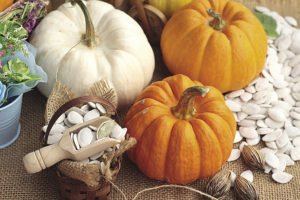Derived from the Greek word pepon, translated from French to English as pompion, then evolved to what we all know as the pumpkin—this harbinger of fall has been a mainstay of North America for over 5,000 years. Its origins are believed to be the Oaxaca region of Mexico, where it looked more like a crooked neck variety of winter squash than the perfectly rounded pumpkin we see today. As a matter of fact, the word pumpkin has no botanical significance; the pumpkin is truly, simply a winter squash variety. It comes from the gourd family, which means its close relatives include cucumbers, zucchini, and melons, such as cantaloupe, honeydew and watermelon.

Commonly grown throughout the western hemisphere, it was extensively used by almost all native people. All parts of the pumpkin are edible, so seeds were roasted and eaten, or pounded into flour. The ‘meat’ of the pumpkin was used in a variety of ways: roasted, boiled and mashed, as a soup base, or dried and stored. The blossoms are also edible and were often added to soups and stews. In addition to its tremendous versatility as a food source, pumpkin shells were dried and used as storage for grain, seeds and beans.
From the Jack-o-lantern to that pumpkin pie at every Thanksgiving celebration, the pumpkin plays a huge role in our American traditions this time of year. The Native Americans of the eastern United States introduced this multi-purpose food to the Pilgrims, helping sustain them through the rough winters, as pumpkins, and winter squash in general, store well. It is believed that the first pumpkin pie was not the perfectly crusted pie we know today, but a hollowed out pumpkin filled with cream, honey, eggs and spices, the top replaced, then nestled in a low burning cooking fire. After it baked, the blackened pumpkin was removed from the fire to reveal a luscious pumpkin custard.
Pumpkins are now grown on every continent except Antarctica. Although some varieties can be grown here in northern Minnesota, they must be short-season varieties more suited to our cooler climate. Pumpkins can be picky. They prefer warm soil (around 60 degrees F.), and soil that holds water well, but not too well. Soil that drains too easily, soil that can become too saturated, or an early frost, can all challenge the pumpkin growing season. Yet the plant can prove to be quite hardy if damaged portions are removed and proper conditions resumed. Stillwater, Minnesota currently holds the record for the largest pumpkin grown; it was 1,810 pounds.
The pumpkin not only helped keep starvation at bay for early settlers, but it also provided them with a nutrient dense food. Pumpkins are a great source of fiber, beta-carotene (hence the bright orange color) and potassium. They also contain some vitamin C as well as beneficial minerals, such as calcium and magnesium. The seeds, also a nutritious food source, are a rich source of zinc, iron, calcium, phosphorous and magnesium. They are also composed of vitamin E, multiple B vitamins and essential fatty acids. Used in the possible treatment and prevention of prostate problems and intestinal worms, pumpkin seeds are a great source of protein and provide a proper balance of amino acids. All winter squash seeds can be removed, cleaned, and roasted, as they are all composed of similar nutrients.
For pottage and puddings and custards and pies
Our pumpkins and parsnips are common supplies,
We have pumpkins at morning and pumpkins at noon,
If it were not for the pumpkins we should be undoon.—Pilgrim verse, circa 1633
Real (not from a can) Pumpkin Pie
1/3 cup shortening or lard
1 cup all-purpose flour
1/4 teaspoon salt
2-3 tablespoons cold water
Cut shortening into flour and salt. Blend with a pastry blender or your hands until it resembles a fine crumble. Sprinkle with cold water until flour is moistened and comes away cleanly from the side of the bowl. Form into a ball and press flat. Roll until large enough to fit a 9-inch pie plate. Place gently into pie plate. Clean and flute the edges.
Filling:
2 cups pureed pumpkin
1 1/2 cups milk
1/3 cup maple syrup
1 teaspoon cinnamon
1/2 teaspoon ground ginger
1/2 teaspoon salt
1/2 teaspoon allspice
1/8 teaspoon ground clove
3 tablespoons flour
There are many ways to transform your pumpkin ‘meat’ to a puree. You can steam 2-inch chunks for 15-20 minutes, or you can boil 2 inch chunks for 8-10 minutes and then puree in a food processor or blender. The preferred method is to halve the pumpkin, remove seeds, then place cut side down in a baking pan with a little water. Cover with foil and bake at 350 degrees F. for 40-50 minutes. When cooled, scoop out the pumpkin.
Preheat oven to 350 degrees F. Blend all ingredients in a food processor or blender and pour into pie shell. Or, for authenticity, mash all the ingredients together with a potato masher (those Native Americans and Pilgrims did not have the luxury of a food processor) and place in the pie shell. Bake for 40-50 minutes. Top with whipped cream.


